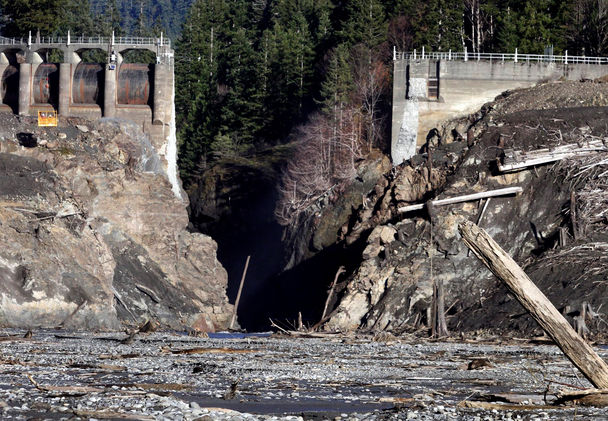There’s more sediment and more wood than expected coming out of the Elwha River as the Elwha dams are taken down — causing more than a few surprises.
By Lynda V. Mapes, Seattle Times

Glines Canyon Dam is two-thirds down, with the Elwha River pouring through the gap. Elwha Dam, 8.6 miles downstream, is already gone.
A mother lode of mud is making its way down the Elwha River, and with it, an armada of floating and waterlogged debris.
Contractors are taking two dams out of the Elwha River as part of a watershed and fishery recovery project that is the largest of its type ever in the world. The first, Elwha Dam, came out a year ago. Glines Canyon dam is about two-thirds gone.
Scientists recently learned there was about 41 percent more sediment trapped behind the dams than originally thought — and that the river is transporting more mud and wood than they expected.
As the river, dammed for 100 years, comes back to life, the other surprise is a forest of waterlogged wood and other organic debris the Elwha is muscling out of the former lake beds of the reservoirs.
All that wood is interacting with the sediment in the river with unpredictable results, said Andy Ritchie, restoration hydrologist for the National Park Service, which is running the Elwha recovery project. He was surprised this winter to see the river building fences and jams of wood that trapped sediment in places where it wasn’t expected, such as at Elwha Campground, or causing erosion in others, such as at the historic Elwha ranger district.
There have been other surprises.
Dam removal was put on hold last October until contractors make more than $1.4 million in emergency retrofits to the new $71.5 million Elwha Water Facilities plant.
It was built as part of the dam-removal project, to clean sediment from the water supply to an industrial pulp and paper plant, a fish-rearing channel and a hatchery. But the plant failed during the first fall rains last October, when fish screens and pumps became clogged with leaves, twigs, branches and sediment.
What the total cost to the project of the breakdown will be — on a plant that was already the single most expensive piece of the $325 million Elwha restoration — and what caused it to fail are still being sorted out, said Barb Maynes, spokeswoman for the park service.
The agency hopes to get contractors back at work taking down Glines Canyon Dam by mid-April. Meanwhile, taxpayers are paying $245,000 to contractor Barnard Construction for the project delay (on top of the repair costs, paid to contractor Macnac Construction of Lakewood) while the water plant is fixed.
Contractors are taking the rest of Glines Canyon Dam down ten feet at a time, and only three whacks remain. The park service still expects to complete dam removal by September 2014, as originally planned.
But even with dam removal on hold, restoration is not standing still.
After a 100-year hiatus, the Elwha is back at work moving sediment, carrying some of it all the way to the river mouth, where a whole new world is emerging.
Surveys both by airplane and by an underwater video camera show a kelp armageddon is under way. The amount of floating kelp at the river mouth and east to the Ediz Hook has already been reduced by 44 percent in the year since dam removal began, said Helen Berry, marine ecologist at the state Department of Natural Resources.
Underwater video also shows a dramatic shift on the sea floor, with a transition in one year from lush pastures of seafloor plants to a war zone of tattered vegetation and large areas nearly denuded.
The reason is sediment. It is blocking light in the water column, and smothering the rocky seafloor with soft mounds of fine material transported by the Elwha, making it unsuitable for the holdfasts which kelp species need to affix themselves to the seafloor.
But scientists think the kelp’s demise is a gain for other species, in a reset of the nearshore ecology to a more normal state. Old maps show no kelp at the river mouth and east to the Ediz Hook.
The accretion of soft sediment is expected to provide habitat for sea grasses that nurture salmon, said Anne Shaffer of the Coastal Watershed Institute in Port Angeles. Soft, sandy beaches also could provide spawning grounds for a chrome tide of sea smelt and sand lance.
“I see it as a return to how things are supposed to be,” Shaffer said. “And we are only at the beginning of these ecological effects.”
Closest to the river mouth, the resumption of the river’s delivery of sediment is also hoped to slow erosion that has claimed up to 100 feet a year in some parts of the tribe’s reservation, east of the river.
Just how much of a difference will be made long term isn’t known, especially when, in about 10 years, the amount of sediment the Elwha delivers annually resumes to its new normal.
But for now, at the river mouth the results are dramatic as the river plays catch-up, gnawing at 100 years of entrapped sediment, and moving it out to sea.
Jonathan Warrick, a scientist at the U.S. Geological Survey Pacific Coastal and Marine Science Center at Santa Cruz, Calif., is helping to map a new sand spit that has formed at the west side of the river mouth. It’s already about one-third of a mile long, and growing.
“I thought it would happen this year,” Warrick said. “But I am a little blown away at how big the bar is.”
